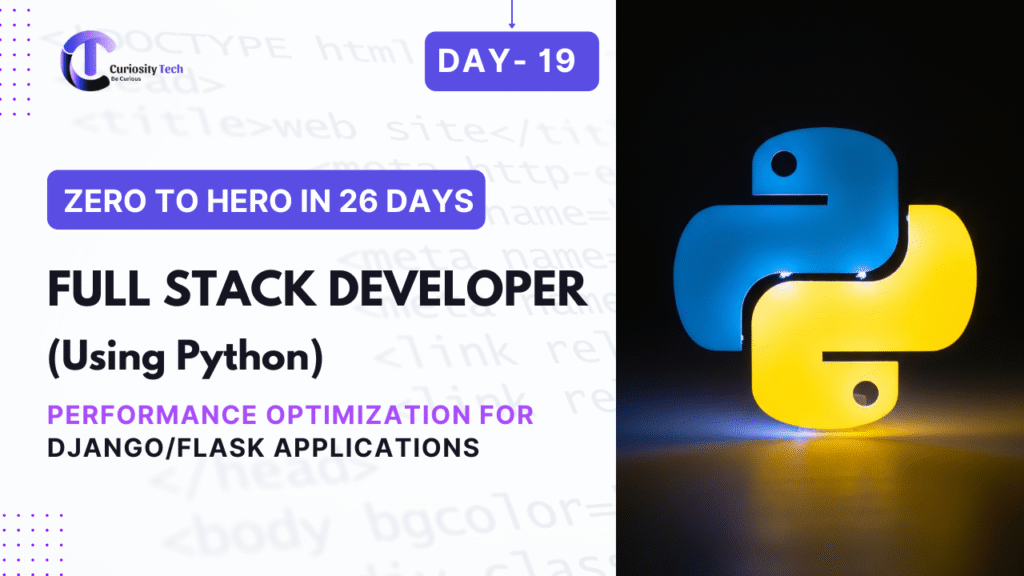Performance is critical for Full Stack Python applications. A slow app frustrates users, increases bounce rates, and impacts business credibility. Whether you’re working on a Django enterprise application or a Flask microservice, understanding performance optimization is essential for modern Full Stack developers.
At CuriosityTech, we emphasize that building a scalable, fast, and efficient app is just as important as writing clean code. In this blog, we’ll explore practical strategies, tools, and best practices to optimize your Python web apps.
Key Performance Metrics
| Metric | Importance |
| Response Time | How fast the app responds to a user request |
| Throughput | Number of requests handled per second |
| Memory Usage | Efficiency of resource consumption |
| Database Query Performance | Reducing latency in database operations |
| Concurrency & Load Handling | Ability to handle multiple users simultaneously |
💡 Analogy: Think of your app as a restaurant kitchen – efficient workflow, fewer bottlenecks, and quick service = happy customers.
Backend Optimization Strategies
1. Database Query Optimization
- Django: Use select_related and prefetch_related to reduce N+1 query problems.
# Inefficient
posts = Post.objects.all()
for post in posts:
author_name = post.author.name # causes extra query per post
# Optimized
posts = Post.objects.select_related(‘author’).all()
for post in posts:
author_name = post.author.name # single query
- Flask (SQLAlchemy): Use joinedload or subqueryload.
from sqlalchemy.orm import joinedload
posts = session.query(Post).options(joinedload(Post.author)).all()
2. Caching
- Cache frequently accessed data using Redis or Memcached.
- Django example:
from django.core.cache import cache
def get_popular_posts():
posts = cache.get(‘popular_posts’)
if not posts:
posts = Post.objects.order_by(‘-views’)[:10]
cache.set(‘popular_posts’, posts, 300) # cache 5 mins
return posts
- Flask example: Flask-Caching can be used similarly.
3. Optimize Middleware & Templates
- Remove unnecessary middleware in Django settings.
- Use template fragment caching for dynamic but repeated components.
- Minimize template logic; move heavy calculations to backend views or APIs.
4. Asynchronous Tasks
- Offload time-consuming tasks to background jobs using Celery + Redis.
- Example: Sending bulk emails, data processing, or report generation.
# tasks.py
from celery import shared_task
@shared_task
def send_welcome_email(user_id):
user = User.objects.get(id=user_id)
# logic to send email
5. Optimize Static Files
- Use CDNs to serve static content (images, CSS, JS).
- Compress and minify assets.
- Django: Use ManifestStaticFilesStorage for caching.
- Flask: Serve static files via Nginx in production.
Frontend & API Optimization
| Optimization Type | Strategy |
| Frontend Rendering | Lazy loading images/components |
| API Calls | Reduce payload size, pagination, caching |
| AJAX Requests | Debounce or throttle frequent requests |
| WebSockets | Use for real-time updates instead of polling |
Monitoring & Profiling
- Django Debug Toolbar: Analyze queries, cache hits, and template rendering times.
- Flask Profiling: Use Flask-Profiler to identify slow endpoints.
- APM Tools: New Relic, Datadog, or Sentry for production monitoring.
Hierarchical Diagram Idea – Performance Layers
Client Side
├─ Optimized JS/CSS/HTML
└─ Lazy Loading / Caching
Backend
├─ Optimized Queries
├─ Middleware Efficiency
├─ Async Tasks (Celery)
└─ API Pagination / Caching
Database
├─ Indexed Columns
├─ Efficient Joins
└─ Connection Pooling

- Visualizing performance optimization in three layers (frontend, backend, database) helps developers target bottlenecks efficiently.
Real-World Example – CuriosityTech Training
Students at CuriosityTech optimized a Python Full Stack e-learning platform:
- Problem: Slow course listing page for 10,000+ users.
- Solution:
- Used select_related for database queries.
- Cached course lists with Redis.
- Minified JS/CSS and served via CDN.
- Offloaded email notifications to Celery workers.
- Used select_related for database queries.
- Result: Page load time decreased from 5s → 0.8s.
Best Practices
- Profile before optimizing – Don’t optimize blindly.
- Use database indexing for frequently queried fields.
- Implement background tasks for non-critical workflows.
- Serve static content via CDN.
- Monitor application continuously using APM tools.

Conclusion
Performance optimization is a critical skill for Full Stack Python developers. Efficient queries, caching strategies, asynchronous processing, and optimized frontend integration can dramatically improve application speed and scalability.
At CuriosityTech, learners gain hands-on experience by profiling, identifying bottlenecks, and applying optimization techniques to real-world Python Full Stack projects, preparing them for professional-grade application development.

